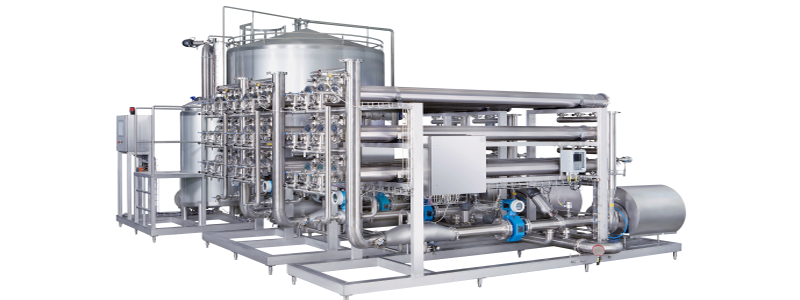Membrane Systems

REVERSE OSMOSIS SYSTEMS
GENERAL INFORMATION ABOUT REVERSE OSMOSIS SYSTEM: Reverse Osmosis (RO),
used in well water and seawater purification processes, is the most precise
filtration process possible. The RO system allows the separation of even ionic
solids from water. A semi-permeable membrane is the main equipment in reverse
osmosis systems. The portion of the water that passes through the membrane is
largely purified, while concentrated impurities on the other side are removed.
Reverse osmosis systems generally employ the horizontal filtration principle,
and the horizontal flow has a continuous cleaning effect on the membrane surface.
One portion of the liquid passes into the product line of the membrane with the
help of pressure, while the other portion moves parallel to the membrane surface
to the waste line, removing the separated impurities (salts, organics, etc.)
from the liquid through the membrane.
In the Reverse Osmosis (RO) process, a driving force is required to move the
liquid across the membrane. This driving force is generated by the pump pressure.
As the pressure increases, the driving force increases. As the concentration of
the liquid remaining on the membrane increases, the driving force required to
move the liquid across the membrane also increases. The most significant
advantage of the Reverse Osmosis system is that it filtration at the ionic level,
largely removing parameters such as hardness and/or alkalinity, as well as all
other dissolved salts, from the water. High-quality water can be obtained from
bitter well water and/or seawater, which are unsuitable for potable or domestic
use due to their high salinity, through Reverse Osmosis. Because Reverse Osmosis
(RO) systems filter ions, suspended solids, and therefore turbidity, must be
removed before passing through the membranes. It is essential to know the
chemical and physical properties of the raw water and have it analyzed. Properly
designed and equipped with high-quality equipment, reverse osmosis systems can
consistently produce high-quality water under more practical and economical
operating conditions than other desalination systems.
Reverse osmosis, also known as hyperfiltration, is the most sensitive filtration
method known. This process enables the separation of particles in a solution,
including dissolved ions. Reverse osmosis is used to purify water and remove
salts and other impurities to improve taste, odor, or other water
characteristics. It can also be used to purify membrane-permeable fluids such as
glycol and ethanol by separating their ions and other contaminants. The most
common use of reverse osmosis is water purification. Reverse osmosis is used to
produce water of high quality that meets the most stringent specifications
currently in effect. Reverse osmosis works with a semi-permeable membrane that
allows the fluid to be purified to pass through it but retains any remaining
contaminants. Most reverse osmosis technologies utilize the cross-flow principle,
which allows the membrane to continuously self-clean. While some of the fluid
passes through the membrane, the remaining fluid continues forward, sweeping
away substances trapped on the membrane surface. The reverse osmosis process
requires a driving force to move the fluid through the membrane, the most
commonly used driving force being the pressure energy of a pump. As pressure
increases, so does the driving force. As the concentration of the separated
fluid increases, the driving force required to concentrate the fluid also
increases. Reverse osmosis can remove bacteria, salts, sugars, proteins,
particles, dyes, and other substances with molecular weights of 150-250 daltons
or greater.
The ion removal efficiency of reverse osmosis increases due to the influence of
particle charges. This means that dissolved ions with an ionic charge, such as
salts, are removed by the membrane with greater efficiency than those removed by
uncharged substances such as organics. The larger the particle size and the
higher its ionic charge, the more efficient its removal by the Reverse Osmosis
membrane. Operating Principles: The cross-flow process is carried out by a
machine consisting of membrane elements and casings, connecting piping, pumps,
pre-filters, and the necessary controls and instrumentation for operation.
Because membrane costs account for 15-40% of the total cost of an RO or UF
device, and because membranes require periodic replacement, careful membrane
selection is essential. Many membrane types are available, each with its own
unique characteristics.
Membrane selection should consider chemical tolerance, mechanical suitability,
washability, contaminant removal performance, flow performance, and cost. As
with other mechanical devices, cross-flow filtration devices operate most
efficiently when the design and materials used are perfectly matched.
After selecting the correct membrane, a design that ensures appropriate cross-flow
values, pressures, and product water yields is essential. A good design will
result in a device with consistent performance, requiring less frequent membrane
cleaning or replacement, consuming reasonable amounts of energy, and requiring
minimal operational monitoring. Many of these factors can also be achieved by
pretreating the influent of the cross-flow unit. Investing in equipment to
properly condition the water before membrane treatment is a significant
investment, though relatively low in comparison to the total cost, due to the
significant benefits it offers. The use of cartridge or bag filters at the inlet
to remove insoluble particles down to 5 microns is essential. The use of
multilayer filters, which can also remove turbidity and filter oxidized metals
such as iron and manganese, is often beneficial. Similarly, dosing pumps are
necessary for dosing acid and antiscalants to maintain salt solubilization, or
biocides to prevent clogging (biofouling) caused by biological growth.
Depending on the nature of the influent, the use of pretreatment units such as
sedimentation tanks or activated carbon filters may also be considered. With
proper pretreatment, the membrane in a cross-flow device will not impose a
higher operating load than anticipated. This results in optimal performance and
the lowest unit cost. Cross-flow filtration offers unparalleled filtration and
purification capabilities, particularly for removing dissolved impurities
smaller than 0.1 microns. The cross-flow process continuously sweeps the
membrane surface, preventing the accumulation of retained impurities, making
membrane filtration processes cost-effective. Successful operation depends on
proper membrane selection, device design, and pretreatment.